We're an affiliate
We hope you love the products we recommend! Just so you know, we may collect a share of sales or other compensation from the links on this page at no additional cost to you. Thank you if you use our links, we really appreciate it!
Did you know that cats can also be taught to walk on a leash? in this article, I will show you how to train a cat to walk on a leash.
Yes, you read that right! Leashes do not just apply to canine companions, you can take your cat on a walk as well!
However, just like a puppy that has not been trained on a leash, a cat that is put on a leash for the first time will be confused unless you teach him to be familiarized with it.
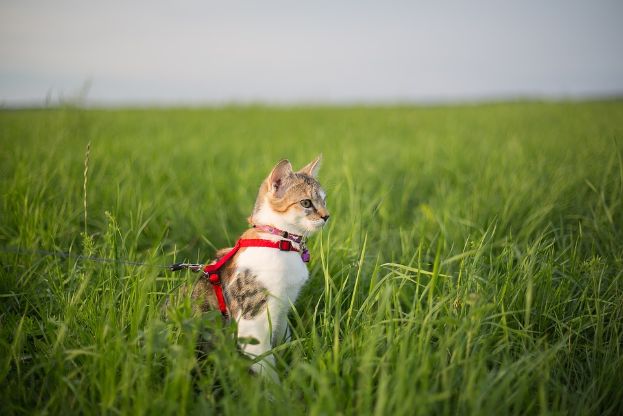
Leash walking can be beneficial not only when you’re outside but also when traveling with your feline friend or taking them to the vet.
It’s also a great way to get your cat to exercise more and relieve some of their unwanted behavioral problems caused by boredom and lack of physical activities.
There are many methods to achieve this training efficiently, and in this article, we will go through it step-by-step to show you how to train a cat to walk on a leash.
How Long Will It Take to Train Your Cat To Walk On a Leash?
Teaching your cat to be on a leash can take a couple of days up to a couple of months, depending on their personality and dependency nature.
If your cat is more laid back, it will take a shorter time to train. On the other hand, if your cat is skittish and likes to just lie down on the floor, then it will take a longer time for them to be trained.
A Comprehensive Guide on How to Train Your Cat To Walk on a Leash
Now that we know which cats are the best candidates for leash training, let me show you how to leash train a cat.
1. Choosing the Right Harness and Leash
Cats are known to have slender and flexible bodies, so putting them on a dog leash will be easy for them to slip out of.
Leash training a cat is different from leash training a dog; that’s why they need different equipment, a harness specifically made for cats.
Collars are suitable for identification and decorative purposes, but not so great to use together with a leash. Harnesses are much more secure for strapping your cat, especially when you are training them.

Choosing the correct sized harness for your cat usually needs trial and error, so it’s best to measure your cat’s chest and shoulders before purchasing a harness. We recommend that you bring your cat along to the pet store to try on the perfect harness fit.
Choose a harness that will fit securely but is not too tight on your cat. You can check if the measurement is comfortable for him by sliding two of your fingers beneath the harness, and if it slides comfortably, then it is the perfect fit. If you can put more fingers or just one finger, it may be too loose or too tight.

Harnesses made from soft clothing and are lightweight are the best choices. Ensure that the harness you choose has a buckle attached to the back of it, as this is where you will attach the leash.
The perfect quality for a cat’s leash is lightweight and manageable. Ideally, you should select a leash ranging from 1 meter to 1.5 meters long.
Retractable leashes and leashes longer than two meters are acceptable to use once your cat is already leash-trained.
2. Introducing the Harness and the Leash
You must slowly introduce the harness to your cat and make it a positive experience, and one way to do it is through food or catnip.
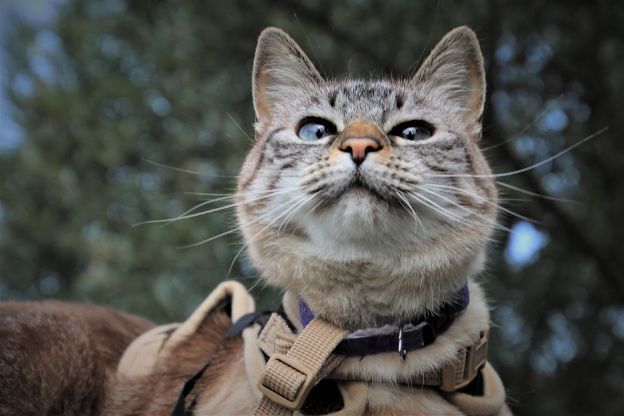
You can leave the harness by your cat’s food bowl or can rub some catnip beneath it so they can sniff it and associate it as a good thing.
3. Putting On The Harness
Once your cat is familiar with the harness, it is time to slip it on him, but do not fasten it yet. Use more treats as a distraction and to help him associate the harness with positive rewards.
It is advisable to put the harness on before mealtime so that the food distracts him from the harness and keeps away his urges to remove it.
Do this for a few more days until you can see that your cat is beginning to be comfortable with it. Once your cat is relaxed, you can fasten the harness.
Leave the harness on for several minutes, and then provide an extra food reward. Do this for several days while checking how your cat reacts to it.
If he seems comfortable in a fastened harness, leave it on a bit longer, but if he gets unsettled, provide food as a distraction and remove the harness from him.
Try again later with a more enticing treat such as canned food or tuna, then remove the harness sooner this time before your cat reacts negatively.

Keep in mind that it is normal for cats to stiffen up, refuse to walk, or walk very strangely during the first few times they’re in a harness.
Your cat has never felt the sensation of something on his back before, so it will naturally take some time for him to adapt to it.
4. Attaching the Leash
Once your cat is all good with the sensation of having a harness on his body, it is time to attach the leash.
Choose a spacious place in your house where no furniture can snag the leash while being dragged by your cat. Let him drag the leash around the room while you’re giving them food or toys as positive reinforcement.

If your cat gets rattled while dragging the leash, you should hold the leash by just sitting on the floor and letting him wander freely around you.
5. Start Leash Walking Indoors
When your cat is comfortable with the harness and leash sensation, start following him around your house and keep the leash loose in your hand. Continue to give him plenty of treats and praise throughout this phase.
Once you’ve both had some practice with this, it’s time to try gently leading him. Gently pull on the leash in your desired direction and call your cat to you.
When he follows your command, reward him with a treat. Continue this process for several days until they are used to walking on a leash in your house.
6. Transitioning to the Outdoors
If your cat is going out of your house for the first time, he will likely be on high alert, so take things slowly by walking him somewhere near, such as your yard or garage.
Don’t let your cat go out of your door on a leash by himself, because he may get used to doing it when he is not leashed.
So instead, pick him up and carry him outside to a quiet area, stay beside him and let him decide when he’s ready to engage in a walk. Keep the leash loose and let your cat go in front of you at a safe distance.
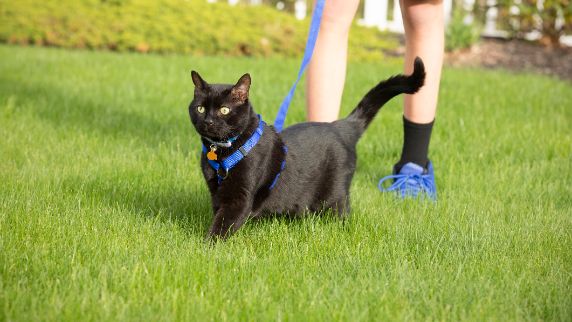
Choose a safe area in your neighborhood where dogs are rarely seen. Having no engagement with a dog will limit any scary experience for your cat that may lead to anxiety every time you take them out for a walk.
Make sure to bring lots of treats when walking outside, and keep the time spent outdoors to a few pleasant minutes. If they are behaving as you want, give them consistent positive reinforcements.
How to Protect Your Cat While Walking Outside
Now that you and your cat are ready to walk the great outside world, here are a few more things to be aware of and consider to have a safe walk.
Fleas
Fleas can result in bad itch, tapeworms, anemia due to blood loss, and many other medical conditions. Fortunately, there are several safe and effective flea medications for cats. There are also flea collars that you can use.
However, it is best to always consult your vet before applying any flea medications to check which one is perfect for your furbaby.
Heartworm
Heartworms are parasites that can be brought in by mosquitos. Heartworms attach to a mosquito’s body, and if an infected mosquito bites your furbaby, it may result in the transfer of parasites.
Heartworm is difficult to detect once it has infected a cat, and there is no available cure. However, there are safe and effective heartworm preventatives you can use on your cat.
Always consult your vet before applying any heartworm treatment to check which one is perfect for your furbaby.
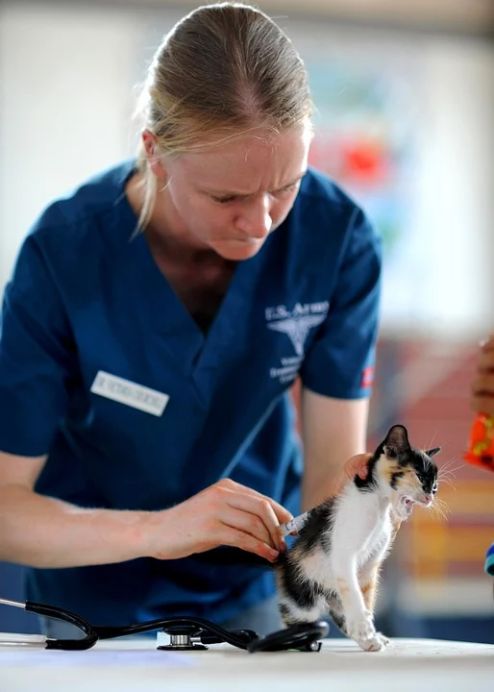
Intestinal Worms
Roundworms and hookworms are digestive parasites that can easily infect cats, especially to those who are frequently walking outside since the eggs of these two intestinal worms are usually found in dirt and mud but can also be present on many outdoor surfaces.
Fortunately, there are heartworm preventives that can be administered by your veterinarian to avoid any of these digestive conditions.
Poisonous Plants For Your Cat
Due to your cat’s curiosity, they will always want to sniff and chew on plants they would encounter while walking. It is essential to take note of the plants that can cause harm to your cat.
Check out our previous article that lists down the most common plants that can be health-threatening when ingested by cats.
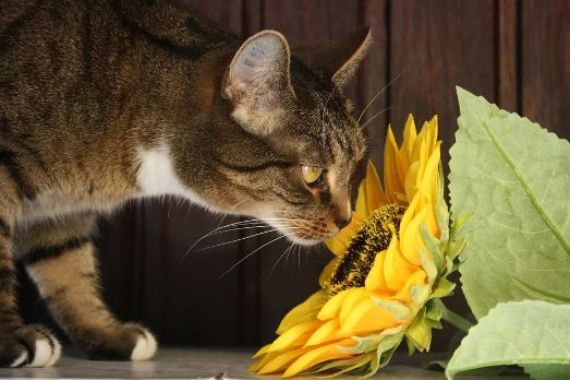
Now that you are armed with the knowledge of how to train a cat to walk on a leash, when will you start the training? Tell us what challenges you encountered and let us know in the comments section below. Have fun, and be safe!
Laura is the founder of Furs'n'Paws. She is a also a pet writer and expert with more than 20 years of experience of working with dogs and cats. She developed a very strong love for animals at a young age. Her passion led her to establish a thriving pet sitting and dog walking business in Dubai. As an expert in pet training, behavior, and nutrition, Laura is committed to helping pet owners and pet lovers by offering high-quality information on a wide range of topics.



No responses yet